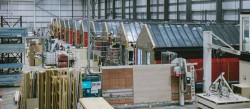Following on from the online Modular Matters conference and exhibition in October, a virtual roundtable focused on volumetric modular technology and the potential opportunities and challenges for providers within the residential sector.
As with much of contemporary life, the discussion took place on the Zoom platform, the ‘virtual roundtable’ looked to focus on some key themes on designing, building and importantly selling volumetric modular technology to a wider client and contractor market. It also touched on concerns surrounding productivity and sustainability that are now an ever-present aspect of project delivery. Here are some key soundbites from the session.
With huge amounts of investment entering offsite manufacturing to fund new factories and innovative products – can these examples of private sector investment sustain the expansion of the offsite manufacturing sector? Can it all just be about the money to make the sector thrive?
Andrew Shepherd, Managing Director, TopHat: “It’s not all about money but you need to produce a viable product that fits into the marketplace and answers a question. The bottom line is that you do have to invest a lot of money to make a highly automated factory. If you want to deal with contracts at scale then there needs to be confidence in the supply chain – that is one of the biggest challenges.”
Nigel Dyke, Director, Alec French Architects: “There is a lack of understanding of the levels of investment required of newer entrants to the market to run a successful business, but they will find a niche or they will leave the market. In some ways volumetric modular is still seen as a niche form of construction, so a lot of funders are nervous of it.”
Neel Khiroya, Managing Director, Excelsior: “Some clients are highly informed – but is there a real understanding of what volumetric can deliver? I think there is a massive gap. The industry needs to try and find an easier way for entrants to enter the market and use modular. Developers also need to understand that there are many different systems available.”
Aviv Brosilovski, Business Development, Forta PRO: “Not a lot of the current manufacturers and people trying to get into the modular market fully understand the scope of becoming a modular production facility at scale. There are a few things that need to be understood, such as how you operate a production line and keep a steady constant flow of work going through it.”
One of the conclusions from the recent report from Cast’s Mark Farmer and HTA’s Mike De’Ath outlining a ‘blueprint for a housing led industrial strategy’ was that modular manufacture could be the ‘biggest single gamechanger’ when it comes to new housing supply with more Government help. With planning often outlined as a culprit in slowing market growth is this possible?
Phillippa Prongue, Executive Director, Apex Airspace: “We need to work with the planners on how you integrate the planning into a project. For example, an airspace development might be allowed through PDR but may need separate consent for the rest of the building if you are changing use. There is quite a lot of work to be done when looking at a whole development perspective.”
Neel Khiroya, Managing Director, Excelsior: “I think the Government can do a lot more to help the industry. I don’t think the lines of communication are open enough. If the Government is serious and want to help modular developments come to the fore, they could help with the tax system or stamp duty reduction to make offsite developments more attractive.”









